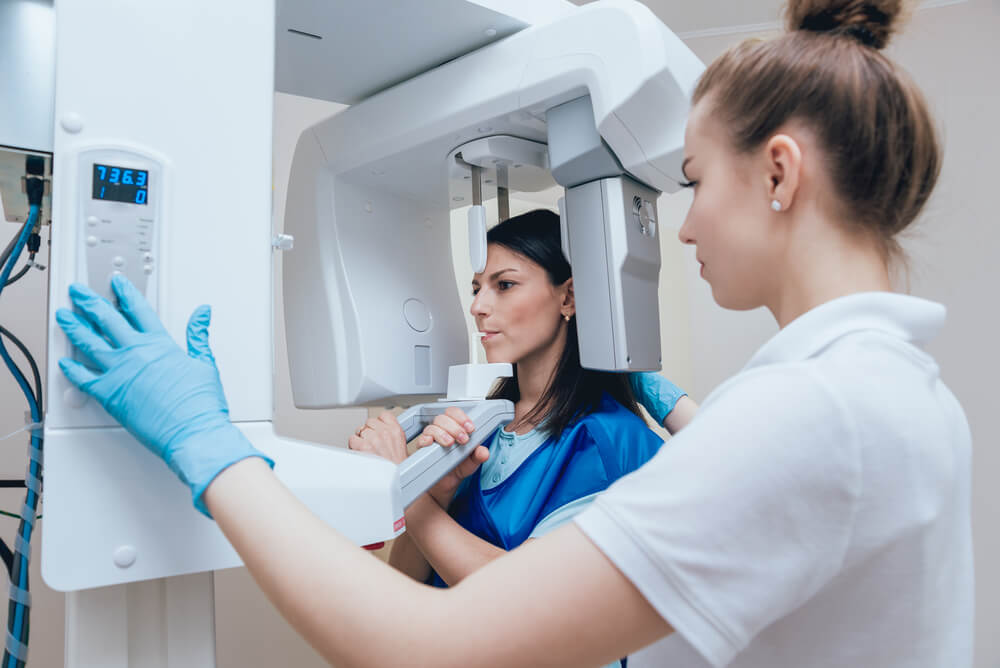Dental imaging is a core part of the diagnostic process. Since its first introduction, the technology has advanced to require less radiation while producing higher quality images. It’s common to undergo dental imaging to update your patient file during each bi-annual visit. Each time you receive an x-ray, multiple images will be taken from various angles. Each of these provides a view of a different part of the oral cavity. Combined, they allow Dr. Rhee to perform a full analysis and identify any existing problems.
Did you know…
that dental x-rays deliver very low levels of radiation and are considered completely safe? In fact, x-rays are even considered safe during pregnancy and while breastfeeding so long as a leaded apron and collar are used to protect your body from exposure. If you are pregnant or think you may be, tell your dentist so proper precautions can be taken.
Receiving Dental Imaging At Dentistry Done Right
As mentioned above, our team will take images from multiple angles during your visit. Below we’re going to discuss the various images taken and what they reveal in your oral cavity.
- Bite-Wing X-Rays – These x-rays reveal a few of the areas from the crown to the roots on one whole side of the face. They help diagnose changes in the density of the bone as well as track the advance of decay. They also help provide a good fitting when restorations are needed.
- Occlusal X-Rays – When a full-arch needs to be imaged, this type of x-ray will be ordered. They help determine tooth placement and track the development of these teeth. They’re typically used for pediatric diagnostics but may also be used for adults.
- Periapical X-Rays – When a root canal treatment must be performed, periapical x-rays will be ordered. These x-rays focus on creating a comprehensive image of a single tooth from root to crown. More minor details, such as the presence of root canals and pulp formation, will also be visible in these images.
- Tomograms – Tomogram X-Rays are used to isolate mouth areas for imaging. The surrounding areas are blurred out. This makes it possible for Dr. Rhee to focus only on the area of concern.
Frequently Asked Questions
Should I get dental x-rays?
Yes. Dental x-rays are capable of identifying tooth decay and damage beneath the surface of the teeth where caries are less visible during an examination. Furthermore, x-rays provide a reference point for the progression of decay in your mouth over time. You should have x-rays taken on a regular basis, but especially if you are experiencing oral health complications or are planning to undergo a dental procedure, such as a root canal.
What should I expect when I get dental x-rays?
Getting traditional dental x-rays can take several minutes. A thick paper tab is placed into the mouth, which you will be asked to bite down on. Most patients find that dental x-rays are completely painless and do not inflict any level of discomfort. In some cases, dentists intraoral x-rays, as well as extra-oral x-rays that snap images of the face, jaw and skull. Extra-oral x-rays are typically used to identify impacted teeth, such as wisdom teeth.
What happens after my dentist has taken x-rays?
Your x-rays will be saved either on film or digitally. In the future, your dentist may request additional dental x-rays every few years to monitor the health of your teeth, gums and jaw over time. If you are considered to be high risk for oral disease or are exhibiting symptoms of complications, your dentist may prefer to take x-rays more frequently.
Dr. Rhee and our team may primarily concern ourselves with the health of your teeth and gums, but it doesn’t end there. The salivary glands are one of those oral structures that fall into our treatment area. A particular form of x-ray known as a sialography focuses on the structures of your salivary glands. Receiving this x-ray includes receiving an injection of dye into these glands that serve to make them visible on the film. Any inconsistencies or abnormalities in their structure will be visible, allowing a precise diagnosis.
Ask Our Team About X-Rays At Dentistry Done Right
If you haven’t already, it’s time to schedule your next visit to Dentistry Done Right. It’s essential that you see us for a check-up every six months to help maintain optimum oral health. When it comes time to undergo dental imaging, don’t be afraid to ask your technician about the films being taken. They’ll go over the process, explain what they’re for, and tell you why taking them is necessary. Call today and schedule your next visit for excellent oral health in Corona, CA.

